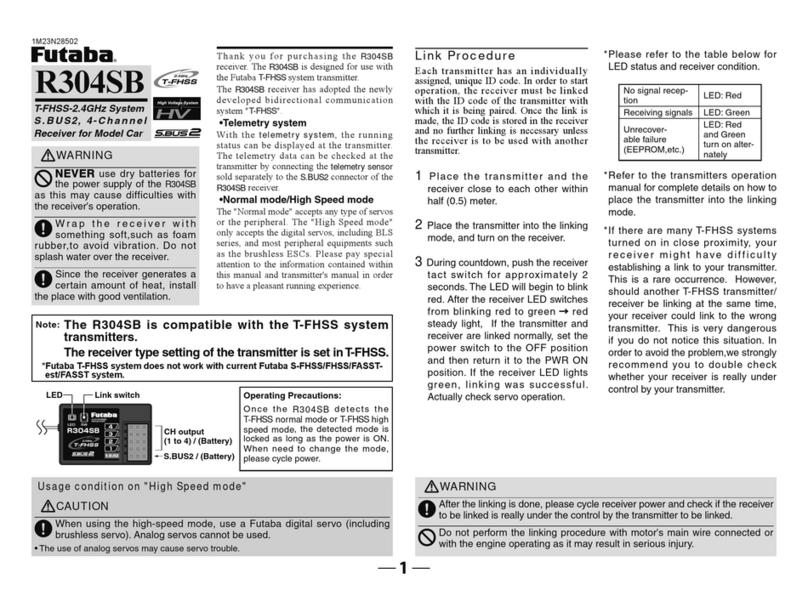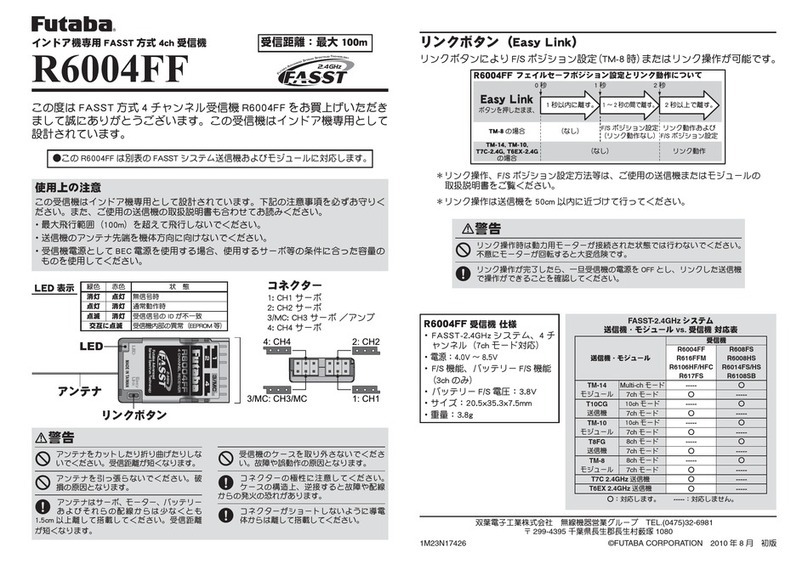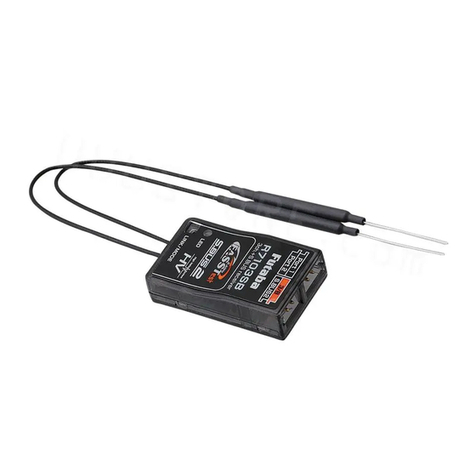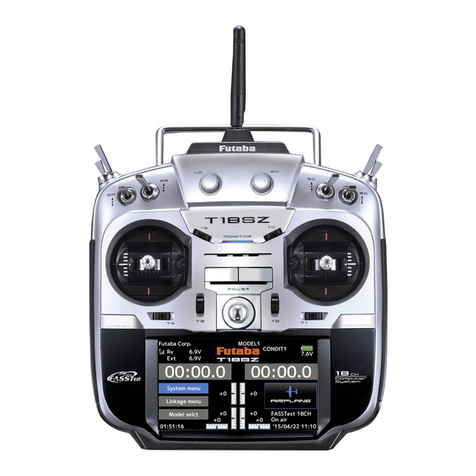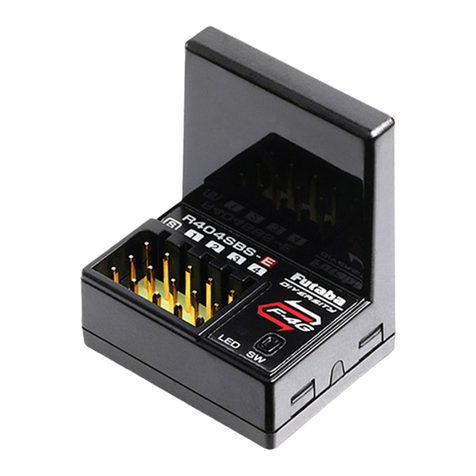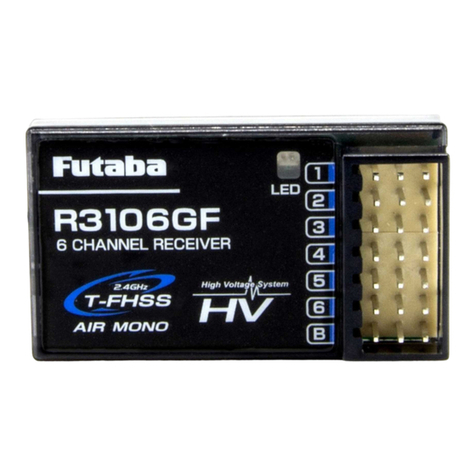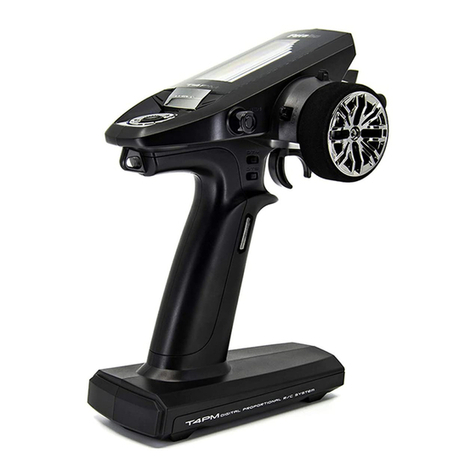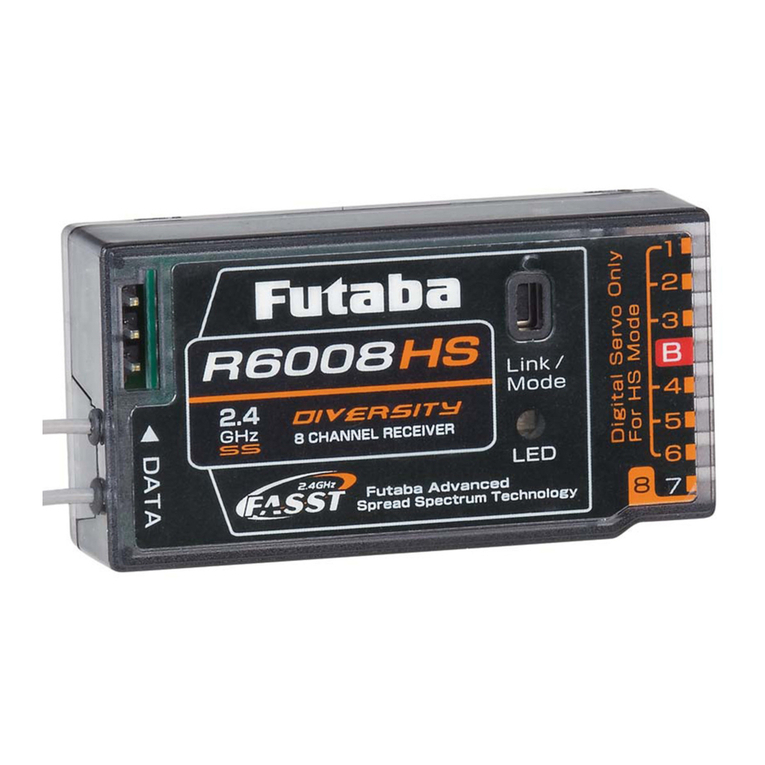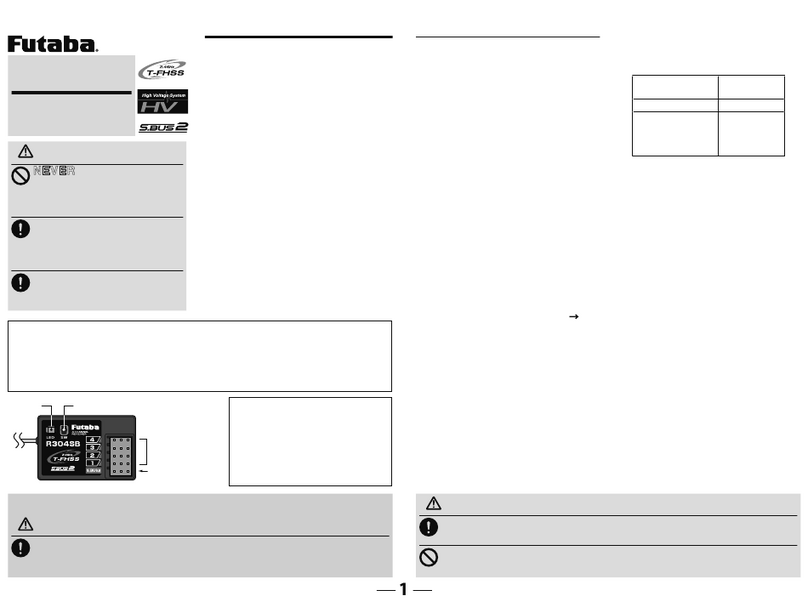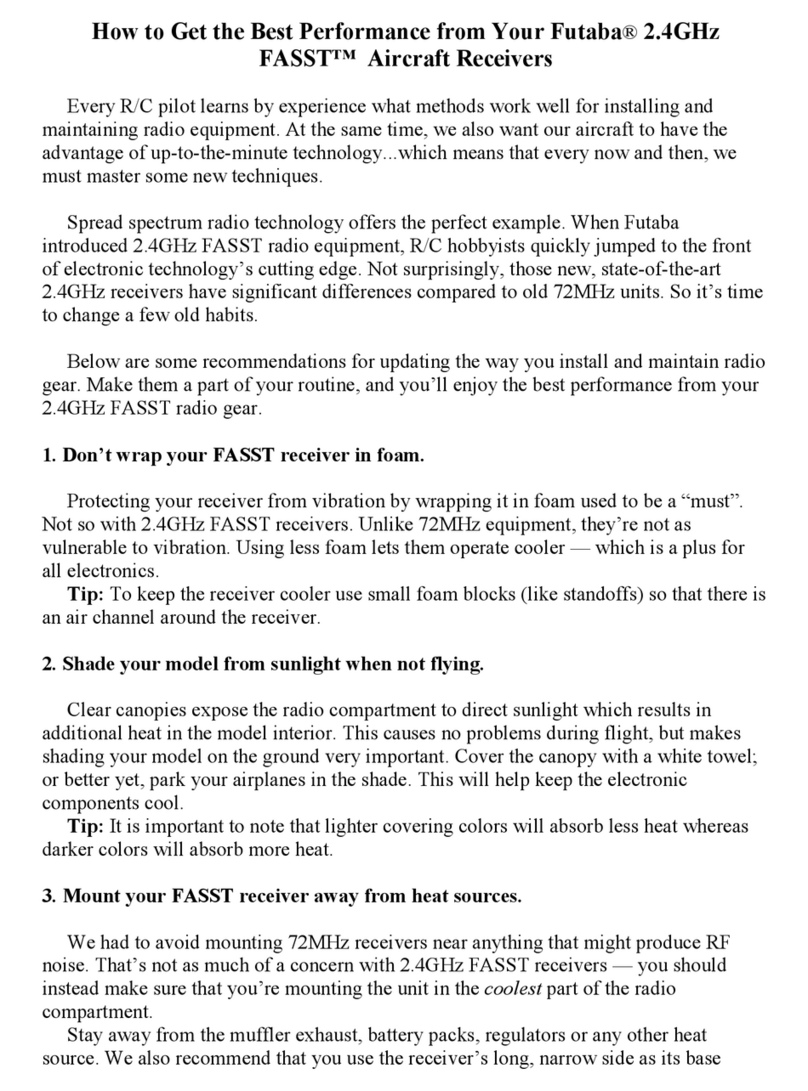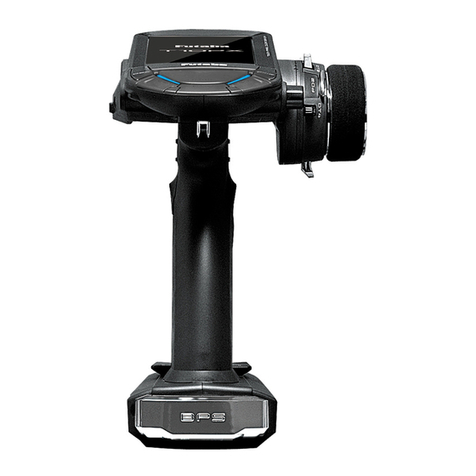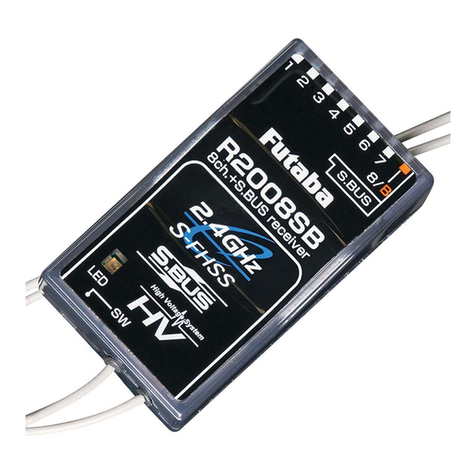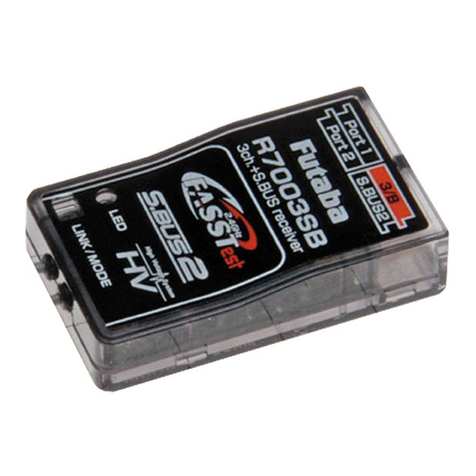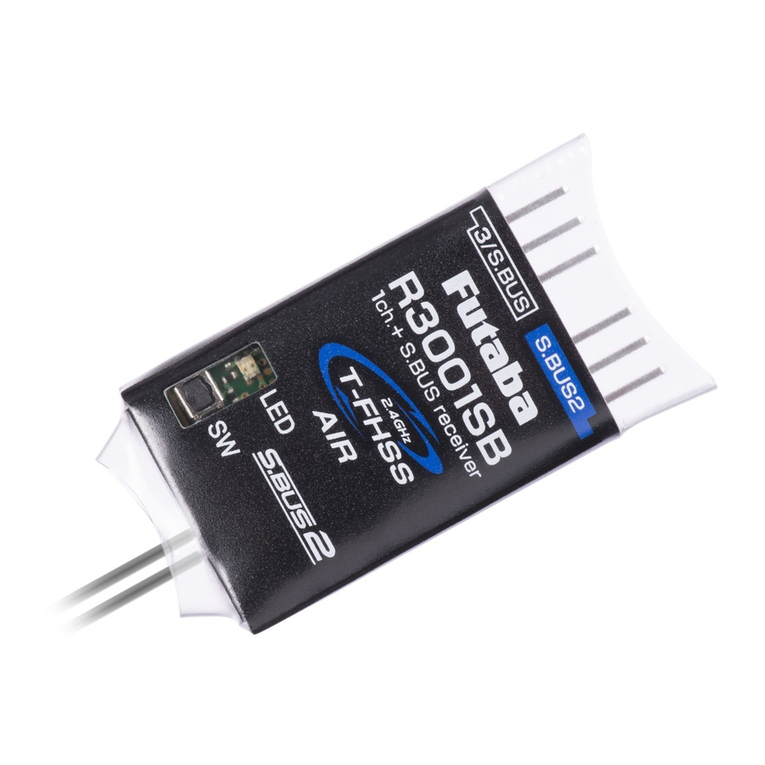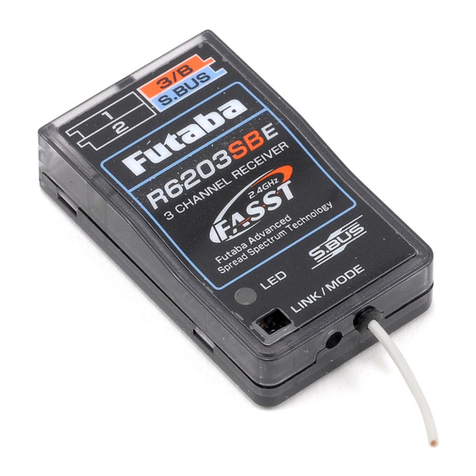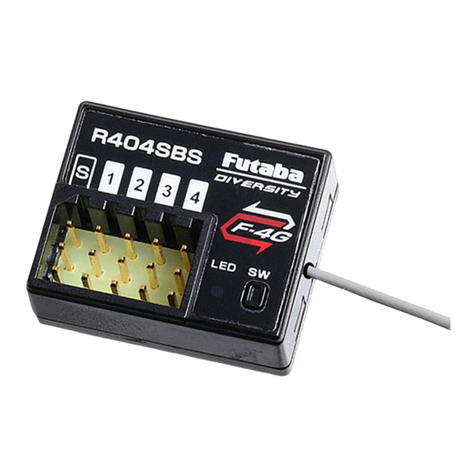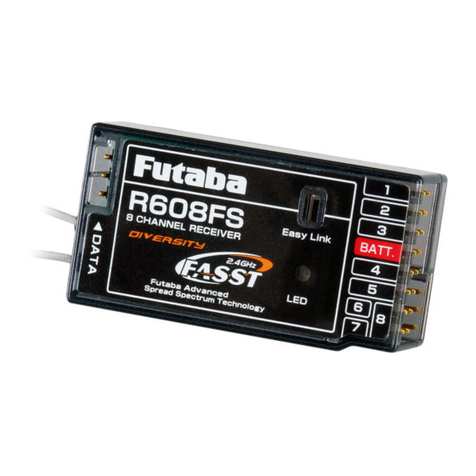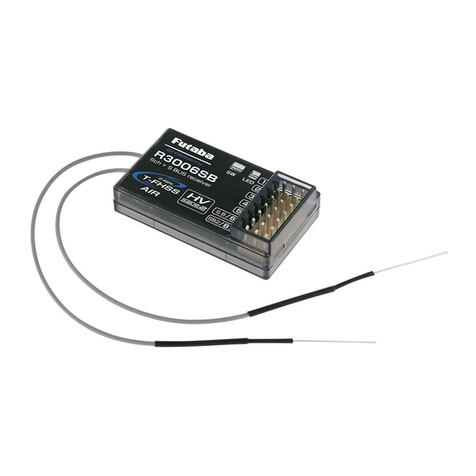
Linktothetransmitter:FASST
1Bring the transmitter and the receiver close to each
other, within 20 inches (half meter).
2Turn on the transmitter and receiver.
3Link operation is performed by the Link/Mode switch.
• When using TM-8 module, it's possible to set F/S position (only 3CH).
0 to 1 sec. 1 to 2 sec. More than 2 sec.
0 sec. 1 sec. 2 sec.
Press and Hold time
No function
With TM-8
(not included in this set)
To set the F/S
position(No re-link)
Re-link(ID set) and to
set the F/S position
No function
Besides TM-8 Re-link(ID set)
*Refer to the instruction manual of the transmitter or module used
for a description of the linking operation, F/S position setting
methods and other details.
WhenusingMultiprop(MPDX-1)
The MPDX-1 can be used with FASSTest by merely
setting the corresponding transmitter. (Refer to the
instruction manual of the corresponding transmitter.)
When using the MPDX-1 Multi Prop Decoder (sold
separately) with the FASST system, change the setting by
the following method.
Enable the MPDX-1 at channels 11 and 12. (Initial value:
OFF)
Channels 11 and 12 cannot be used individually for
MPDX-1 output.
The MPDX-1 extends 1 channel to 8 channels. However,
since the response speed becomes slower and there are
functional restrictions, use it at simple switch operation
and other applications that require numerous channels.
MultipropmodeChangemethod
1. Switch the receiver to the FASST system (Normal or
High-speed).
2. Turn on the receiver power. (Transmitter power off)
3. Press the Link/Mode switch for at least 10 seconds.
4. When the LED blinks red and changes to red/green
simultaneous rapid blinking, release the switch.
5. The receiver enters the multi prop mode and the LED of
the current mode blinks. (Initial value: OFF)
6. Each time the switch is pressed, the mode changes.
7. When the receiver was switched to the desired mode,
press the Link/Mode switch for at least 2 seconds.
8. When the LED switches to red/green simultaneous
rapid blinking, mode switching is complete. Release the
switch.
9. When switching is complete, turn on the power. When
the power is turned on, the receiver switches to the new
mode.
FASST
When switched, the R7018SB can use the FASST-Multi-ch mode. When the FASST system is used, the telemetry and
Extra Voltage ports cannot be used. The FASST system has a Normal mode and a High-speed mode. However, in the
High-speed mode, analog servos cannot be used at CH1 〜6.
GreenLEDblink Mode
1time MultipropmodeOFF
2time MultipropmodeON
FASSTest FASST
Whenatelemetryadapter(TMA-1)isused
:FASSTestonly
When using a TMA-1 (sold separately), change the
settings by the following method.
The TMA-1 is a device for viewing the telemetry data on
a smartphone or tablet.
R7018SBandTMA-1linkingmethod
1. Switch the receiver to FASSTest system.
2. Link the transmitter and receiver, and after confirming
operation, turn off the power.
3. Turn on the receiver power. (Transmitter power off)
4. Press the Link/Mode switch for at least 10 seconds.
5. After the LED blinks red and changes to red/green
simultaneous rapid blinking, release the switch.
6. The receiver enters the linked with TMA-1 mode, and
the LED begins red/green simultaneous rapid blinking.
7. Press the TMA-1 link switch until the LED starts to blink
and wait for the TMA-1 to link.
8. When TMA-1 linking is complete, the TMA-1 LED
changes from red to green for a moment.
9. When linking is complete, turn on the receiver power
and check the operation of all the devices.
03';ق2SWLRQك
FUTABA CORPORATION
1080 Yabutsuka, Chosei-mura, Chosei-gun, Chiba-ken, 299-4395, Japan
Phone: +81 475 32 6982, Facsimile: +81 475 32 6983
©FUTABA CORPORATION 2015, 4 (1)
R7018SBSpecifications
FASSTest-2.4GHz system(18CH/12CH mode)FASST-2.4GHz system
(Multi-ch mode)
S.BUS2 and S.BUS port and Linear 16 ch +Digital 2 ch for conventional
system receiver
• Dual antenna diversity
• Size: 2.15 x 1.59 x 0.64 in. (54.6x40.4x16.3mm)
• Weight: 1.48 oz. (42g)
• Power requirement: 6.0V to 7.4V(Voltage range: 4.8 to 8.4V)
• Battery F/S Voltage: It sets up with a transmitter (F/S can't be used in
case of FASST.)
• Extra Voltage port: 0 〜70V DC
- 4-
All product and company names mentioned
herein are the trademarks or registered
trademarks of their respective owners.
本產品符合低功率電波輻射性電機管理辦法 第十二條、第十四條等條文規定
1. 經型式認證合格之低功率射頻電機,非經許可,公司、商號或使用者均不得擅自變更頻率、加
大功率或變更原設計之特性及功能。
2. 低功率射頻電機之使用不得影響飛航安全及干擾合法通信;經發現有干擾現象時,應立即停用,
並改善至無干擾時方得繼續使用。前項合法通信,指依電信法規定作業之無線電通信。低功率
射頻電機須忍受合法通信或工業、科學及醫療用電波輻射性電機設備之干擾。

